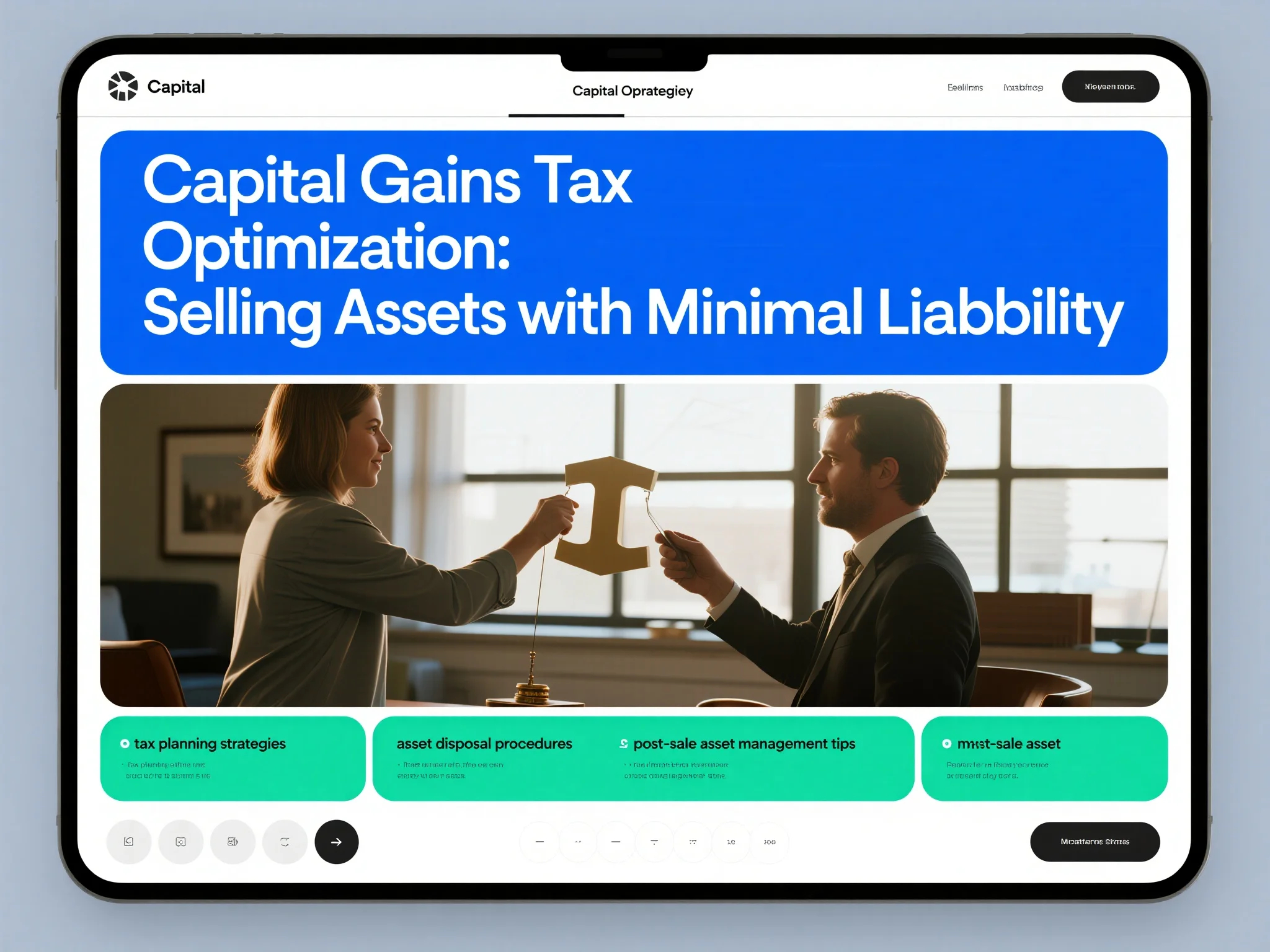Understanding Capital Gains Tax Optimization and Strategic Asset Sales The sophisticated landscape of capital gains tax optimization provides investors and high-net-worth individuals with comprehensive strategies to minimize tax liability when selling appreciated assets through careful timing, strategic planning, and utilization of available tax benefits that can significantly reduce the overall tax burden while maximizing after-tax proceeds from investment sales and asset dispositions. Capital gains tax optimization encompasses a multifaceted approach that combines timing strategies, loss harvesting, holding period management, and strategic asset selection to create comprehensive frameworks that minimize tax liability while supporting overall investment objectives and wealth management goals across various asset
classes and market conditions. The effectiveness of capital gains tax optimization depends on proper understanding of tax regulations, careful planning of asset sales, and coordination with broader tax and investment strategies to ensure that tax minimization techniques support overall financial objectives while maintaining compliance with applicable tax laws and regulations. Professional capital gains tax planning requires coordination between experienced tax professionals, investment advisors, and wealth managers who understand the complex interplay between tax regulations, investment strategies, and market timing to create optimal approaches that minimize tax liability while supporting long-term wealth accumulation and preservation objectives. The regulatory environment for capital gains taxation continues to evolve with changes in tax rates, holding period requirements, and available deductions that require ongoing monitoring and potential adjustment of optimization strategies to maintain effectiveness and ensure continued compliance with current tax regulations while adapting to changing market conditions and investment opportunities. The selection of appropriate capital gains optimization techniques requires careful analysis of asset types, holding periods, tax basis, and overall investment portfolio to develop customized approaches that provide sustainable tax benefits while supporting comprehensive investment management and wealth preservation strategies that benefit investors across various economic environments. Advanced capital gains tax planning often involves sophisticated strategies and coordination with other tax planning techniques that can provide significant tax advantages while creating opportunities for portfolio optimization and wealth enhancement that support long-term financial success and investment objectives across changing market and regulatory conditions.High Net Worth Tax Strategies USA for Capital Gains Management The comprehensive implementation of high net worth tax strategies USA for capital gains management encompasses sophisticated approaches that coordinate asset sales with broader tax optimization techniques, estate planning strategies, and wealth management objectives to create integrated solutions that minimize overall tax liability while supporting long-term wealth preservation and investment goals across multiple asset classes and investment vehicles. High net worth capital gains planning requires careful consideration of multiple tax implications including federal and state capital gains rates, net investment income tax, and alternative minimum tax considerations that can significantly impact the after-tax proceeds from asset sales and require comprehensive analysis to optimize overall tax efficiency while achieving investment and liquidity objectives. The coordination of capital
gains planning with charitable giving strategies provides additional opportunities for tax optimization through techniques such as charitable remainder trusts, donor advised funds, and direct charitable gifts of appreciated assets that can eliminate capital gains tax liability while supporting philanthropic objectives and providing income tax deductions that enhance overall tax efficiency. International considerations for high net worth capital gains planning include cross-border tax implications, foreign tax credit opportunities, and compliance with international reporting requirements that can impact the effectiveness of capital gains optimization strategies for investors with international assets, business interests, or residence considerations that require specialized expertise and planning coordination. The timing aspects of high net worth capital gains planning involve strategic coordination with market conditions, tax law changes, and family circumstances to optimize the benefits of asset sales while maintaining flexibility for changing economic and regulatory environments that could impact long-term investment and tax planning effectiveness. Asset allocation and portfolio management within high net worth capital gains planning requires sophisticated analysis of tax efficiency, risk management, and return optimization to ensure that investment strategies support capital gains optimization while maintaining appropriate diversification and risk management that align with long-term financial goals and investment objectives. The integration of capital gains planning with business succession strategies can provide additional tax benefits while supporting family business objectives through techniques that combine asset sales with ownership transfer strategies that enhance overall tax efficiency while supporting business continuity and succession planning goals that benefit multiple family members and generations. Estate planning coordination with capital gains optimization involves strategic use of stepped-up basis opportunities, generation-skipping strategies, and trust structures that can enhance the effectiveness of capital gains planning while supporting long-term wealth transfer and estate tax minimization objectives that benefit multiple generations of family members.Investment Tax Credits USA and Capital Gains Coordination
The strategic utilization of investment tax credits USA in coordination with capital gains optimization creates powerful opportunities for tax reduction through careful planning of investment timing, asset selection, and credit utilization that can significantly enhance after-tax investment returns while supporting broader tax optimization and wealth management objectives across various investment strategies and asset classes. Investment tax credits provide valuable opportunities to offset capital gains tax liability through strategic investment in qualifying assets and activities including renewable energy projects, historic rehabilitation, low-income housing, and other credit-generating investments that can provide dollar-for-dollar tax reductions while supporting portfolio diversification and investment objectives. The coordination of investment tax credits with capital gains realization requires sophisticated timing strategies that optimize the utilization of available credits while managing the recognition of capital gains to minimize overall tax liability and maximize after-tax investment returns through careful planning of asset sales and credit-generating investment activities. Renewable energy investment tax credits offer significant opportunities for capital gains optimization through strategic investment in solar, wind, and other qualifying renewable energy projects that can provide substantial tax credits while generating investment returns and supporting environmental objectives that align with many investors’ values and long-term investment strategies. Historic tax credits provide additional opportunities for capital gains coordination through investment in qualifying historic rehabilitation projects that can generate significant tax credits while providing real estate investment opportunities and supporting community development objectives that enhance overall investment portfolio diversification and social impact. Low-income housing tax credits create opportunities for capital gains optimization through investment in affordable housing projects that provide tax credits over extended periods while generating investment returns and supporting social objectives that align with many high net worth investors’ philanthropic and investment goals. The timing and structuring of investment tax credit strategies requires careful coordination with capital gains planning to ensure optimal utilization of available credits while managing the tax implications of investment exits and asset sales that could impact overall tax efficiency and investment returns over extended time periods. Professional oversight and compliance management for investment tax credit strategies involves ongoing monitoring of credit requirements, compliance obligations, and regulatory changes that could impact credit availability and effectiveness while ensuring continued optimization of capital gains tax planning and overall investment tax efficiency across changing regulatory and market environments.

Alternative Investment Tax Strategies and Capital Gains Optimization
The sophisticated implementation of alternative investment tax strategies provides investors with powerful tools for capital gains optimization through strategic utilization of specialized investment structures, timing techniques, and tax-advantaged vehicles that can significantly reduce tax liability while enhancing investment returns and supporting portfolio diversification objectives across various alternative asset classes. Alternative investment structures including private equity, hedge funds, real estate partnerships, and commodity investments offer unique tax advantages through specialized partnership structures, carried interest treatment, and depreciation benefits that can enhance capital gains optimization while providing access to investment opportunities not available through traditional investment vehicles. Qualified opportunity zone investments provide exceptional capital gains optimization benefits through deferral and potential elimination of capital gains tax liability for investors who reinvest capital gains proceeds in qualifying opportunity zone funds within specified timeframes, creating powerful incentives for investment in designated economically distressed communities while achieving significant tax benefits. Real estate investment strategies offer comprehensive capital gains optimization opportunities through depreciation deductions, like-kind exchanges, installment sales, and other specialized techniques that can defer or reduce capital gains tax liability while supporting real estate investment objectives and portfolio diversification goals that enhance overall investment returns and tax efficiency. Private placement investments and alternative investment funds can provide capital gains optimization benefits through specialized tax structures, timing flexibility, and professional management that can enhance tax efficiency while providing access to institutional-quality investment opportunities and strategies that may not be available through traditional investment channels. Commodity and natural resource investments offer unique capital gains optimization opportunities through depletion allowances, percentage depletion, and other specialized tax benefits that can reduce effective tax rates while providing portfolio diversification and inflation protection that support long-term investment objectives and wealth preservation goals. The coordination of alternative investment strategies with traditional portfolio management requires sophisticated analysis of tax efficiency, risk management, and return optimization to ensure that alternative investments enhance overall portfolio performance while supporting capital gains optimization and broader wealth management objectives across changing market conditions and regulatory environments. Professional due diligence and ongoing management of alternative investment tax strategies involves comprehensive analysis of investment structures, tax implications, and regulatory compliance to ensure that alternative investments provide intended tax benefits while maintaining appropriate risk management and supporting overall investment and tax planning objectives that align with long-term financial goals and wealth management strategies.
Estate Tax Minimization Strategies and Capital Gains Planning Integration
The comprehensive coordination of estate tax minimization strategies with capital gains planning creates integrated approaches that address both current tax optimization and long-term wealth transfer objectives while supporting family wealth preservation and estate planning goals through sophisticated techniques that maximize tax efficiency across multiple generations and asset transfer strategies. Estate planning integration with capital gains optimization involves strategic use of stepped-up basis opportunities, generation-skipping techniques, and trust structures that can eliminate or reduce capital gains tax liability while facilitating wealth transfer and estate tax minimization that benefits multiple generations of family members through coordinated tax and estate planning strategies. The timing coordination between estate planning and capital gains realization requires careful analysis of current tax rates, potential future changes in tax law, and family wealth transfer objectives to optimize the benefits of combined strategies while maintaining flexibility for changing circumstances and regulatory environments that could impact long-term planning effectiveness and family financial security. Grantor trust strategies provide powerful tools for combining estate tax minimization with capital gains optimization by allowing grantors to pay income taxes on trust income while removing trust assets and future growth from the taxable estate, thereby providing additional wealth transfer benefits while optimizing capital gains tax treatment for trust beneficiaries and supporting long-term family wealth management objectives. The use of charitable remainder trusts and other charitable planning techniques can enhance capital gains optimization while supporting estate tax minimization through strategies that eliminate capital gains tax liability while providing income streams for grantors and charitable benefits that enhance overall tax efficiency and family legacy building objectives. Generation-skipping transfer tax planning within estate tax minimization strategies can extend the benefits of capital gains optimization across multiple generations by utilizing generation-skipping exemptions and trust structures that provide ongoing tax benefits while facilitating wealth transfer and capital gains optimization for future generations of family members. Family limited partnerships and limited liability companies provide opportunities for capital gains optimization while supporting estate tax minimization through valuation discounts, management control, and ongoing wealth transfer capabilities that enhance overall family tax efficiency and support long-term wealth management and estate planning objectives across multiple generations. The ongoing management and adjustment of integrated estate tax and capital gains strategies requires regular review of tax law changes, family circumstances, and asset performance to ensure continued effectiveness and optimization of both current tax benefits and long-term estate planning advantages that support comprehensive family wealth management and multi-generational financial success across changing economic and regulatory environments.
Advanced Capital Gains Optimization Techniques and Market Timing
The sophisticated implementation of advanced capital gains optimization techniques and strategic market timing provides investors with powerful tools for minimizing tax liability through careful coordination of asset sales, loss harvesting, and portfolio rebalancing strategies that can significantly enhance after-tax investment returns while supporting long-term wealth accumulation and investment objectives across various market conditions and economic environments. Tax loss harvesting strategies provide fundamental tools for capital gains optimization through systematic realization of investment losses to offset capital gains while maintaining desired portfolio allocation and investment exposure through careful selection of replacement securities and adherence to wash sale rules that ensure tax benefits while supporting ongoing investment objectives. The strategic timing of capital gains realization involves sophisticated analysis of market conditions, tax rate changes, and personal financial circumstances to optimize the timing of asset sales while minimizing tax liability and maximizing after-tax proceeds through careful coordination of multiple factors that impact overall investment and tax efficiency. Asset location strategies enhance capital gains optimization by strategically placing investments in tax-advantaged accounts versus taxable accounts based on their expected tax treatment and return characteristics, thereby optimizing overall portfolio tax efficiency while maintaining desired asset allocation and risk management objectives that support long-term investment success. Direct indexing and separately managed accounts provide advanced capital gains optimization opportunities through individual security ownership that enables sophisticated tax loss harvesting, charitable giving strategies, and customized tax management that can significantly enhance after-tax returns compared to traditional mutual fund and ETF investments while maintaining broad market exposure and diversification. Options strategies and derivatives can provide capital gains optimization benefits through techniques such as protective puts, covered calls, and collar strategies that can manage downside risk while optimizing the timing and tax treatment of capital gains realization through sophisticated risk management and tax planning coordination. International tax planning for capital gains optimization includes strategic use of foreign tax credits, treaty benefits, and international investment structures that can enhance tax efficiency for investors with global investment exposure while maintaining compliance with international reporting requirements and tax regulations that govern cross-border investment activities. The coordination of retirement account distributions with capital gains optimization requires sophisticated planning to manage the tax implications of required minimum distributions, Roth conversions, and other retirement account strategies while optimizing capital gains realization in taxable accounts to minimize overall tax liability and support comprehensive retirement and investment planning objectives across extended time periods and changing tax environments.
Implementation, Compliance, and Future Planning Considerations
The successful implementation and ongoing management of capital gains tax optimization strategies require sophisticated systems, professional oversight, and regular monitoring processes that ensure tax minimization techniques maintain their effectiveness while adapting to changing market conditions, tax regulations, and investment objectives that could impact long-term optimization success and overall investment performance. Implementation planning for capital gains optimization involves comprehensive coordination between tax professionals, investment advisors, and wealth managers to ensure that tax strategies support overall investment objectives while maintaining compliance with applicable tax laws and regulations that govern capital gains treatment and investment activities across various asset classes and investment vehicles. Professional advisory coordination for capital gains optimization requires ongoing collaboration between certified public accountants, investment advisors, estate planning attorneys, and other specialists who can provide specialized expertise and support for complex tax optimization strategies while ensuring continued effectiveness and regulatory compliance across changing market and regulatory environments. Monitoring and review processes for capital gains optimization include regular assessment of portfolio performance, tax efficiency, and strategy effectiveness that ensures optimization techniques continue to meet investment objectives while adapting to changing market conditions and tax regulations that could impact long-term planning effectiveness and investment success. Technology integration in capital gains optimization includes advanced portfolio management software, tax optimization tools, and reporting systems that enhance the efficiency and effectiveness of tax planning strategies while providing real-time oversight of optimization opportunities and compliance requirements that support sophisticated investment and tax management across multiple accounts and asset classes. Risk assessment and adjustment procedures for capital gains optimization involve ongoing evaluation of market risks, tax law changes, and strategy effectiveness that ensures optimization techniques remain appropriate for current circumstances while identifying opportunities for enhancement and improvement of tax efficiency and investment performance across changing economic and regulatory environments. Compliance considerations for capital gains optimization include comprehensive record keeping, tax return preparation, and regulatory reporting that ensures optimization strategies maintain their tax benefits while meeting all applicable compliance requirements and supporting tax positions in the event of examination or audit procedures that could challenge optimization techniques and tax treatment. Future considerations for capital gains optimization include potential changes in tax law, market conditions, and investment opportunities that may require proactive adjustments to optimization strategies to maintain optimal benefits and ensure continued effectiveness in achieving investment and tax objectives across multiple market cycles and changing regulatory environments that could impact long-term planning success and investment performance.




